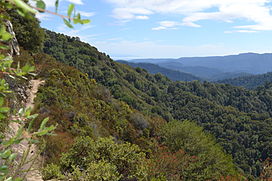| Castle Rock State Park | |
|---|---|
IUCN category V (protected landscape/seascape) | |
 The Santa Cruz Mountains from Castle Rock State Park, with Monterey Bay in the distance. | |
| Location | Santa Cruz, Santa Clara, and San Mateo Counties, California, United States |
| Nearest city | Los Gatos, California |
| Coordinates | 37°13′50″N 122°05′44″W / 37.2306°N 122.09568°W |
| Area | 5,242 acres (2,121 ha) |
| Established | 1968 |
| Operator | California Department of Parks and Recreation |
Castle Rock State Park is a 5,242-acre (2,121 ha) state park of California, United States, located along the crest of the Santa Cruz Mountains and almost entirely in Santa Cruz County, with parts extending into Santa Clara County and San Mateo County.[1] It embraces coast redwood, Douglas fir, and madrone forest, most of which has been left in its wild, natural state. Steep canyons are sprinkled with unusual rock formations that are a popular rock climbing area. The park is named after a sandstone formation called Castle Rock. The forest here is lush and mossy, crisscrossed by 32 miles (51 km) of hiking trails. These trails are part of an even more extensive trail system that links the Santa Clara and San Lorenzo valleys with Castle Rock State Park, Big Basin Redwoods State Park, and the Pacific Coast. Due to its overnight parking lot, Castle Rock is a popular starting point for the Skyline-to-the-Sea Trail, a 30-mile (48 km) trail that begins near by at Saratoga Gap and leads to Waddell Beach north of Santa Cruz. There are two walk-in campgrounds within the park for overnight backpacking.[2]
- ^ "California State Park System Statistical Report: Fiscal Year 2009/10" (PDF). California State Parks: 30. Archived (PDF) from the original on July 14, 2012. Retrieved July 24, 2017.
{{cite journal}}: Cite journal requires|journal=(help) - ^ "Natural History". California Department of Parks and Recreation. Archived from the original on September 1, 2019. Retrieved December 15, 2019.

